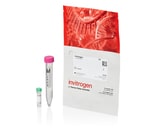Search
SiteClick™ sDIBO Alkyne Kits for Antibody Labeling
| Número de catálogo | Etiqueta o tinte | Escala de etiquetado |
|---|---|---|
| S10914 | pHrodo™ Deep Red | 100-250 µg |
| C20027 | Alexa Fluor™ 488 | 100-250 µg |
| C20029 | Alexa Fluor™ 647 | 100-250 µg |
| C20031 | Amina primaria | 100-250 µg |
| C20034 | pHrodo™ iFL rojo | 100-250 µg |
| S10902 | Biotina | 1 mg |
| S10903 | pHrodo™ iFL rojo | 1 mg |
| S10904 | Alexa Fluor™ 488 | 1 mg |
| S10906 | Alexa Fluor™ 647 | 1 mg |
| S10907 | Biotina | 5 mg |
| S10908 | pHrodo™ iFL rojo | 5 mg |
| S10909 | Alexa Fluor™ 488 | 5 mg |
| S10911 | Alexa Fluor™ 647 | 5 mg |
| S10915 | pHrodo™ Deep Red | 1 mg |
| C20028 | Alexa Fluor™ 555 | 100-250 µg |
| C20030 | Biotina | 100-250 µg |
Genere conjugados de anticuerpos etiquetados específicos del sitio con los alquinos SiteClick sDIBO para el etiquetado de anticuerpos. Nuestros kits de etiquetado de anticuerpos de sDIBO SiteClick están optimizados para su uso junto con los kits de modificación con azida SiteClick (S20026, S10900 o S10901, que se venden por separado) y contienen reactivos suficientes para realizar una reacción de conjugado de una etiqueta de alquino sDIBO SiteClick utilizando 100 μg, 1 mg o 5 mg de anticuerpo IgG modificado con azida. Los alquinos sDIBO SiteClick para el etiquetado de anticuerpos utilizan química de clic sin cobre para vincular covalentemente un colorante Alexa Fluor etiquetado con dibenzociclooctinas (sDIBO), un colorante pHrodo o biotina a un anticuerpo modificado con azida. La etiqueta, cuando se une al anticuerpo, se encuentra lejos de su dominio de unión al antígeno.
El kit de modificación con azida de anticuerpos SiteClick (n.º cat. S20026, S10900, S10901) se recomienda para la unión de una fracción de azida a las cadenas pesadas de un anticuerpo IgG sin etiquetar. También son adecuados otros anticuerpos diseñados que contienen fracciones de azida.
Cuando se utiliza junto con el kit de modificación con azida de anticuerpos SiteClick, los kits de alquino sDIBO SiteClick para el etiquetado de anticuerpos le ofrecen la opción de probar diferentes etiquetas fluorescentes para su anticuerpo, unir otras moléculas mediante estreptavidina o unir su propia molécula mediante fracciones reactivas a las aminas, dependiendo de su ensayo. Nuestros alquinos sDIBO son versiones mejoradas ciclooctinos DIBO originales, que producen conjugados que son menos «pegajosos» y emiten un fondo de señal más bajo en las muestras biológicas.



